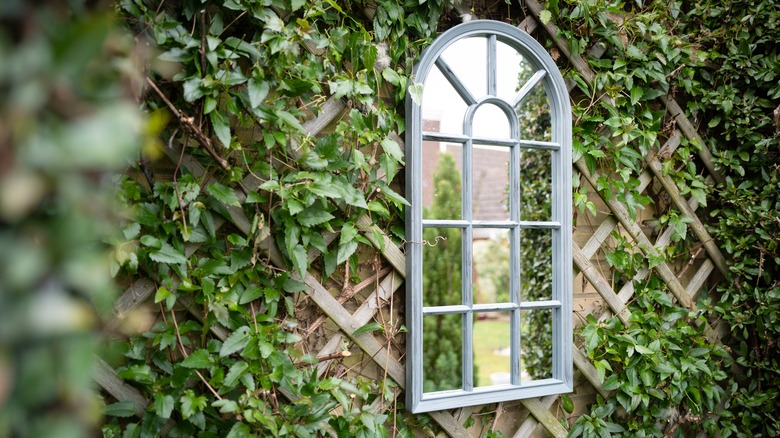Use A Trellis To DIY A Stunning Greenery Display On Your Fence
We may receive a commission on purchases made from links.
Trellises are an incredible multi-purpose framework you can use around your home in many ways. They're typically used for climbing fruits and vegetables to support and help their harvest grow perfectly in gardens. However, you can also use trellises to support other growing plants while sprucing up your outdoor space. They work superbly to add privacy and shade to the backyard. They also elevate a mundane wall, taking it from drab to fab when you create intricate designs with climbing vines. You can easily DIY a stunning greenery display with a trellis in your backyard to add color and texture. TikTok user @homewithchrissym, Christine Melin, created a gorgeous diamond-shaped design with star jasmine (Trachelospermum jasminoides) vines and a trellis made of wire.
This trellis DIY takes a couple of days to set up due to pre-planning, measuring, and installing the materials, but it can also take up to a year to see the results when your plants are fully grown. However, it's worth the wait. You end up with a fence full of lush greenery. The best part about this DIY project is that anyone can do it. Whether you have a small balcony or wide brick walls, you can design a greenery display. Melin made her display on a brick wall, so you might only need some of the materials she uses, especially if you have a different siding.
Create your design and purchase materials
It's crucial to pre-plan your diamond trellis to give yourself an estimate of the materials you need to purchase. Measure the size of your fence and create your desired diamond pattern to map it out on your wall later. Sketching out a design on a piece of paper will help you visualize what it will look like when you set it up. Christine Melin created simple large diamonds, but you can make multiple diamond patterns that connect in two or three rows. If you don't want to cover the entire wall with greenery, plan to cover only half so you can decorate the other half differently. A larger space can occupy additional seating against the brick wall, and you can display other hanging plants to break up the fence.
For this DIY, a few materials you'll need are a couple of packs of 1/16th galvanized uncoated steel wire rope, 1/16th aluminum ferrules, brick anchors from Home Depot, multiple packs of stainless steel eye hooks from Amazon, wirecutters, hammer drill with masonry drill bits, a hammer, needlenose pliers, a level, a marker, and painter's tape. Of course, you'll need climbing plants. Melin used the star jasmine plant for her brick wall, but you can include clematis, cypress vine, sweetpea, and many other vining plants. Once you pre-plan and buy your materials, it's time to start bringing your design to life.
How to DIY a stunning greenery display
Start by outlining where each "X" will go on the wall with a pencil or pen. Painter's tape gives you a better visual, especially if you want to avoid drawing on the brick. Before drilling and adding your anchors, ensure the distance between each end is level and evenly spaced. It's vital to double-check your measurements to avoid drilling too many holes. If it's your first time, there are things to consider before drilling into brick. Next, drill your holes at the bottom and top of the "Xs" with the hammer drill and masonry bit for a brick wall, and add your anchors. After your anchors are secure, install your eye hook screws.
Next, thread your 1/16th steel wire through the eye hooks to create diagonal lines for the "Xs" and use wirecutters to cut the ends to make individual segments. Loop the steel wire twice through the eye hooks and twist to secure. You can use the aluminum ferrules to secure the wire and keep it taut. Insert the wire through one hole of the ferrule, then thread it through the eye hook and back through the second hole. Repeat with all of your diagonal lines. Once your "Xs" are complete, drill center holes where the lines connect and secure them with another eye hook. Finally, set up vining plants next to each diagonal line and wrap the vines around each line so that they start growing over it.

